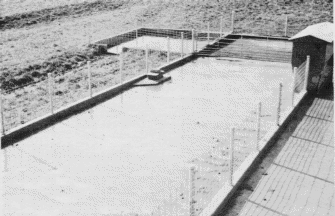
ID-114-W

Under law, runoff from open feedlots must be controlled so that it does not enter a stream. Settling basins and infiltration channels are simple, effective, economical means of runoff control.
Construction need not be elaborate, and, depending on soil type, topography and sophistication of the design, it should be possible to construct a system on most farms for $3 or less per head.
In some cases, the area needed for infiltration may be too large and a holding pond will prove more economical. Alternatives for runoff control systems are shown in Figure 1.
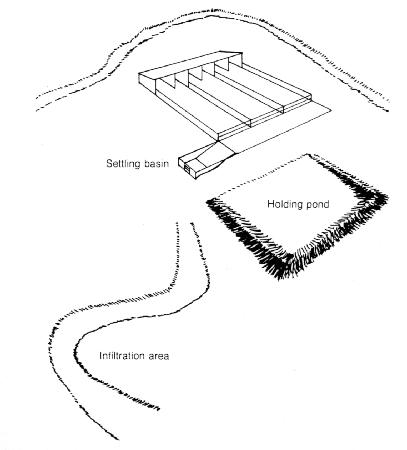
Research results from the settling basin at the Throckmorton Purdue Agricultural Center and the settling basin and infiltration channel at the Lynnwood Purdue Agricultural Center show that between 60 and 75 per cent of the manure solids settle out of the runoff in the settling basin. And, about 50 per cent of the nitrogen is left in the settling basin. The infiltration area effectively absorbs all the runoff from the settling basin.
A grass such as fescue seeded in the infiltration area can effectively utilize the nutrients. All extra drainage water must be diverted away from the infiltration channel. Holding ponds contain the runoff until it can be applied to agricultural land with a low cost irrigation system. The fertilizer nutrients that are contained in the waste water are utilized by the crops that are irrigated.
To design a settling basin and infiltration channel the area of the feedlot and the soil type must be known. The settling basin is designed for the runoff from the 1-year, 1-hour storm which is 1.2 inches over most of Indiana. The infiltration area is designed to absorb the runoff from the 25-year, 48-hour storm which is 5.5 inches over most of Indiana. The holding pond is designed to contain the runoff which would occur during the period when the holding pond cannot be emptied.
The settling basin is designed to slow the runoff and allow the larger manure solids to settle. The runoff should be held in the basin for 15 to 30 minutes. The surface area of the basin is found by dividing the feedlot runoff rate (cubic feet per hour) by 4 cubic feet/hour/square foot. The surface settling rate of 4 cubic feet/hour/square foot has been found to be effective for settling the solids from feedlot runoff.
To find the area of the settling basin, make the following calculations:
Settling basin area (sq.ft.) = feedlot area (sq.ft.) x 1 yr. 1 hr. storm (ft./hr.) ÷ 4
OR
Settling basin area (sq.ft.) = feedlot area (sq.ft.) ÷ 40 where the 1 yr 1 hr storm = 1.2 inches = .1 ft (Indiana weather)
The depth of the settling basin depends on the amount of solids that would accumulate in the basin Approximately 20 per cent of trio manure on the lot will be carried oft in the runoff
If the lot is cleaned weekly, the settling basin should be 2 feet deep
If the lot is cleaned less frequently, the depth should he increased to contain settled solids. The depth should be increased a foot for each month that solids will he stored.
The overflow from the settling basin will depend on how the basin is emptied. If liquid manure handling equipment is available, a weir notch should be used as the overflow (Figure 2). If the settling solids are to be handled with conventional solid manure handling equipment. a porous dam can be constructed of 2x6 lumber with a 1 1/2" spacing between boards (Figure 3 and 4). The length of dam should be about 2 feet. A riser pipe with 1 x 4-inch slots are shown in Figure 5 can also be used to allow the liquids to drain away from the settled solids.
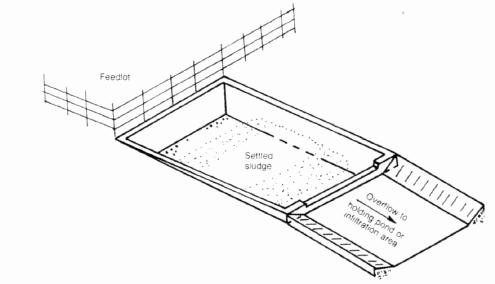
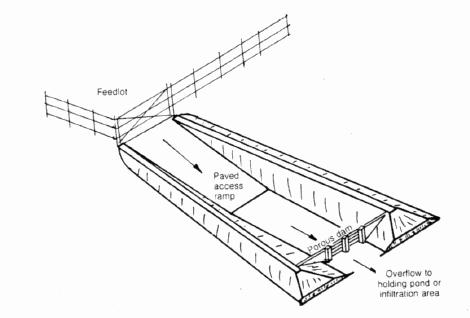
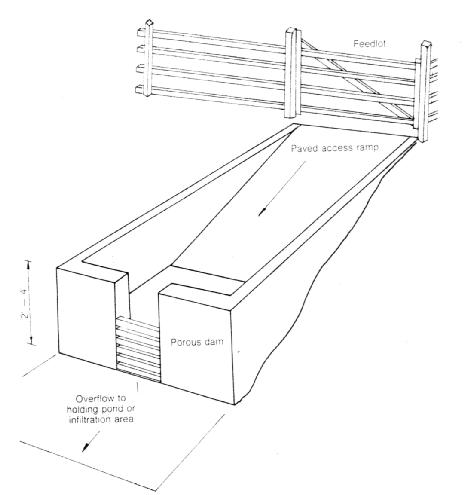
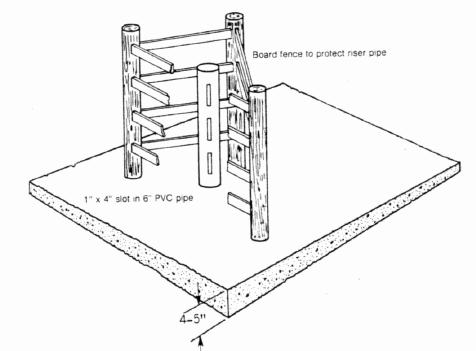
The infiltration channel is designed to absorb the runoff. The water holding capacity for the soil determines the channel area required. For Indiana, or other areas where the design storm is 5.5 inches. the total area is found by multiplying the area of the feeding floor by the multiplier shown in Table 1.
For other areas, the multiplier can be calculated as follows:
Multiplier = design storm (in.) ÷ [water holding capacity (in.) - design storm (in.)]
The area of infiltration area can be found by making the following calculations:
In filtration area (sq. ft.) = multiplier x lot area (sq. ft.)
The width of the infiltration channel should be less than 20 feet. All other surface runoff must be diverted away from the channel. The first 50 feet of channel adjacent to the settling basin should have a 1 per cent slope to keep manure solids from depositing next to the basin and preventing proper drainage away from the basin. The remaining channel should be divided into two or three sections. If the channel is less than 600 feet, the slope of the first section should be .4 per cent and the slope of the second section should be .2 per cent. If the channel is longer than 600 feet, the channel should be divided into 3 sections with slopes of .4 per cent, .3 per cent and .2 per cent respectively.
If the infiltration channel is longer than 1,200 feet. it may be advisable to divert the runoff into several channels or to use a relatively flat field as an infiltration area. The water holding capacity of sandy soils is very low and if an infiltration area is used, care should be taken to insure that a crop or grass is grown in the channel to prevent nutrients from moving through the soil and entering ground water. In some cases, the area required for an infiltration area will be too large and a holding pond should be considered. Where there is a very high seasonal water table, it may be advisable to install drainage tile adjacent to the infiltration channel.
inches/5 feet
Soil texture of depth Multiplier
------------------------------------------
Sandy loam 6.5 5.5
Silt loam 11 1.0
Silty clay loam 10 1.25
Clay 9 1.5
------------------------------------------
Holding ponds are constructed to store runoff from feedlots. Although settling basins are not always used to pretreat the runoff that enters the holding pond, the use of a basin is recommended. With a settling basin, the holding pond will produce fewer odors, the liquid will be more easily handled with irrigation equipment, and the life of the holding pond will be extended.
The volume of the holding pond will depend on the surface condition of the feedlot and the storage time needed. In Indiana, 90 days storage of runoff is usually adequate. The Indiana Soil Conservation Service has developed a design criteria for 90 days storage of runoff in holding pond, which is based on the lot surface and rainfall data (Figures 6 and 7).
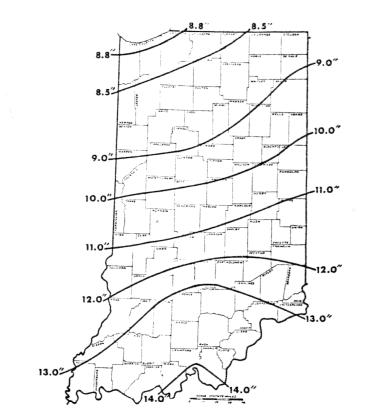
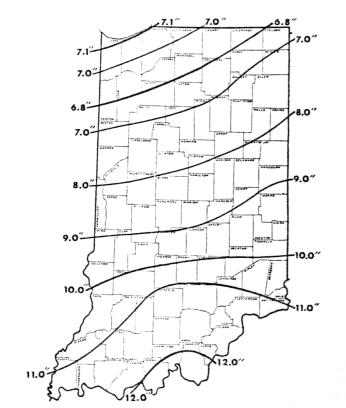
For longer storage periods, the runoff amount should be increased by factors shown in Table 2. The total runoff is calculated as follows:
Runoff (desired period) = multiplier (Table 2) x runoff (Fig. 5 & 6)
The volume of the runoff holding pond can be determined by:
Volume (cu ft.) = (runoff) (inch) ÷ 12 in./ft) x feedlot area (sq. ft)
The dimensions of the holding pond can be found from Table 3 on page 8.
Holding ponds are usually emptied with irrigation equipment. A 50 gallon per minute pump with two 3/8 - inch nozzles can empty a 10,000 cu.ft. holding pond in 30 hours. Such a system could be purchased for $1,500 or less.
Proper construction of the runoff control system is essential. Most contractors are familiar with methods of constructing holding ponds. However, settling basins and infiltration channels are relatively new, and care should be taken to insure that certain guidelines are followed.
If the settled solids in the settling basin are to be handled with conventional solid manure handling equipment, floor of the basin should be 4-to 5-inch thick reinforced concrete poured over a good sand or gravel base. One wall of the basin should be reinforced so that it can be used as a bucking wall. Depth of the basin should be limited to 2 feet.
If long term storage of the settled solids is needed, surface area of the basin should be enlarged. If the settled solids will be handled with liquid manure equipment, the basin can be deeper than 2 feet. If a manure tanker will be driven next to the basin, the vertical sidewalls should be reinforced.
Days Multiplier
---------------------------------
90 1.0
120 1.28
150 1 58
180 1.88
----------------------------------
The infiltration channel should not be confused with a waterway. The top soil in the channel should not be disturbed. In many locations, the channel can be laid out along the natural topography, and a diversion terrace built along the channel to prevent outside surface water from entering it. The terrace around the channel need not be more than 1 foot high to contain the feedlot runoff in the channel.
If excavation is necessary, the topsoil should be returned to the channel bed after removing the required amount of subsoil. It is also important that the channel not be heavily compacted during construction.
A grass, such as rye grass or fescue, should be sown in the channel as soon after construction as possible. If a drainage tile is needed to control the seasonal high water table, the subsurfaced drainage should be 4 inches diameter and installed 30 to 40 inches deep, 10 feet on either side of the channel.
Runoff control can be accomplished on almost all livestock farms with settling basins, infiltration areas or holding ponds. The size and type of components that are used can vary.
This paper has presented the basic design information needed to develop an effective system of runoff controls. After studying this paper and computing the areas. required for each component (see design worksheet and example on pages 6 and 7). the producer should be able to select the system which best suits his situation.
Example: Design a runoff control system for a paved open feedlot in Lincoln County, Indiana which is shown in the illustration below The soil type in the area is silty clay loam. The feedlot and settling basin will be cleaned once a month. If a holding pond is used. the runoff must be stored for 120 days.
Your
Solution: Example Situation
--------------------------------------------------------------------------------------------------------
1. Feedlot area
Width x Length measured) 68' x 105' = 7140 sq.ft. __________
2.Runoff to settling basin (from 1 year-1 hour
storm)
Feedlot area x rainfall (1.2 inches for most of 7140 x (1.2" ÷ 12"/ft.) __________
Indiana) = 714 cu ft.
3.Settling basin area
a. Feedlot area divided by 40 (good for condi-
tions where the 1 year-1 hour storm is 1.2 in.) 7140 ÷ 40 = 179 sq.ft. __________
or
b. Runoff from 1 year-1 hour storm divided by 4 714 ÷ 4 = 179 sq. ft. __________
4. Settling basin width and length
a. Width (entry-way to basin( 12'
b. Length settling basin area (3) width (4a) 179 ÷ 12 = 15' __________
5. Settling basin depth
a. Minimum depth 2' __________
b. Solid storage (number of months stored x 1') 1 x 1' = 1 __________
c. Total depth (sum of 5a and 5b) 3' __________
6.Runoff of infiltration area (48-hour, 25-year
storm)
Feedlot area (1) x rainfall (5.5 inches for most of 7140 x (5.5" ÷ 1.2"/ft.)
Indiana) = 3300 cu.ft. ___________
7.Available water receiving capacity
Water holding capacity (Table 1 ) - rainfall (48-
hour, 25-year storm) 10" - 5.5" = 4.5" ___________
8. Infiltration area
Runoff to infiltration area (6) available water 3300 ÷ (4.5" ÷ 12"/ft.)
receiving capacity (7) = 8800 sq.ft. ___________
9. Dimension of infiltration channel
a. Width (20 ft. maximum) 20' ___________
b. Length = area ÷ width (if greater than 1200,
use multiple channels) 8800 ÷ 20 = 440' ___________
10. Divide channel into sections
1st 50' @ 1% 50' __________
1/2 remaining length @ .4% (440 - 50) ÷ 2 = 195' __________
remaining length @ .2% 195' ___________
11. Runoff to be stored in holding pond
Runoff for lot condition (Figure 4 or 5) x factor
for extended storage (Table 2) 9" x 1.28 = 11.5" ___________
12. Holding pond volume
Feedlot areas (1) x runoff (11) 7140 x (11.5" ÷ 12"/ft.)
= 7000 cu.ft. ___________
13. Holding pond dimension (Table 3)
Select depth 6' ____________
Select width 50' ____________
Read length 59' ____________
--------------------------------------------------------------------------------------------------------------
Recommendations: A settling basin and infiltration area would be the most economical system and the management requirements would be minimal. A grass, such as fescue, or a crop should be grown in the infiltration area and all outside runoff water must be diverted away from the infiltration channel.
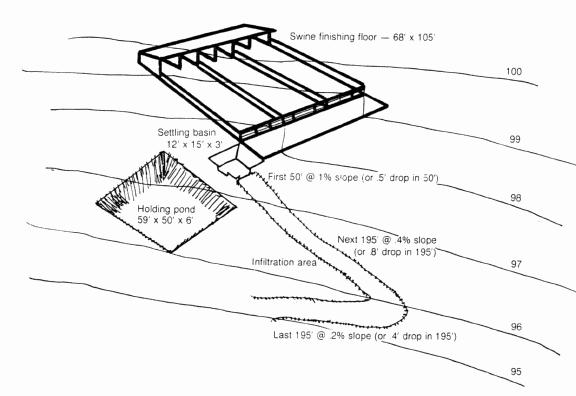
Lengths of Holding Ponds
----------------------------------------------------------------------------------------------------------
Total Depth
6 FEET 9 FEET 15 FEET
USABLE ------------------------------ ------------------------------ --------------------------------
VOLUME INTERIOR WIDTH (FEET) INTERIOR WIDTH (FEET) INTERIOR WIDTH (FEET)
----------------------------------------------------------------------------------------------------------------------------
(CUBIC FT X 1000) 50 75 100 150 200 50 75 100 150 200 75 100 125 150 200
3. 34.
4. 41. 31.
5 47. 34.
e. 53. 37. 31. 50.
7. 59. 41. 34. 55.
8. 65. 44 36. 60.
9. 71. 48. 39 31. 65.
10 77. 51. 41. 32. 70. 47.
11. 84. 55. 44. 34. 75. 50.
12. 90. 58. 46. 35. 30. 90. 52.
13. 96. 62. 48. 37. 31. 85. 55.
14. 102. 63. 51. 38. 33. 90. 57. 47.
15 108. 69. 53. 40. 34. 95. 60. 48.
16. 114. 72. 56. 41. 35. 100. 62. 50.
17. 121. 76. 58. 43. 36. 105. 65. 52.
18. 127. 79. 61. 44 37. 110. 67. 53.
19. 133. 83. 63. 46. 38. 115. 70. 55.
20. 133. 96. 65. 47. 39. 120. 72. 57
22. 151. 93. 70. 50. 41. 130. 77. 60. 46.
24. 164. 100. 75. 53. 44. 140. 82. 63. 48. 77.
26. 176. 107. 80. 56. 46. 150. 87. 67. 50. 81.
28. 188. 114. 85. 59. 48. 160. 92. 70. 52. 85.
30. 201. 121. 90. 62. 50. 170. 97. 73. 54. 46. 90.
32. 213. 128. 94. 65. 52. 180. 102. 77. 56. 47. 94.
34. 135. 99. 69. 54. 190. 107. 80. 58. 49. 98.
36. 142. 104. 71. 57. 200. 112. 83. 60. 50. 102. 76.
38. 143. 109. 74. 59. 210. 117. 87. 62. 51. 106. 78.
40. 156. 114. 77. 61. 220. 122. 90. 64. 53. 110. 81.
45. 173. 121. 85. 67. 135. 98. 69. 56. 120. 87.
50. 191. 138. 93. 72. 147. 107. 74. 60. 130. 93. 77.
55. 208. 150. 100. 77. 160. 115. 79. 64. 141. 99. 81.
60. 225. 162. 109. 83. 172. 123. 84. 67. 151. 105. 86. 75.
65. 243. 174. 119. 88. 185. 132. 89. 71. 161. 111. 90. 78.
70. 250. 187. 123. 94. 197. 140. 94. 74. 171. 117. 94. 82.
80. 295. 211. 138. 105. 222. 157. 104. 81. 192. 128. 102. 88.
90. 330. 235. 153. 116. 247. 173. 114. 89. 212. 140. 111. 95. 78.
100. 259. 168. 127. 272. 190. 124. 96. 232. 152. 119. 101. 82.
150. 381. 244. 182. 273. 174. 131. 334. 212. 161. 134. 104.
200. 319. 236. 357. 224. 167. 271. 203. 166. 127.
250. 394. 291. 440. 274. 203. 331. 245. 199. 149.
----------------------------------------------------------------------------------------------------------------------------
NOTES: 1. TOTAL DEPTHS INCLUDE A 1 FOOT FREEBOARD. 2. THE SIDE SLOPE IS 2.5 TO 1
New 1/76
Cooperative Extension work in Agriculture and Home Economics, state of Indiana, Purdue university, and U.S. Department of Agriculture cooperating; H. A. Wadsworth, Director, West Lafayette, IN. Issued in furtherance of the acts of May 8 and June 30, 1914. The cooperative Extension Service of Purdue university is an affirmative action/equal opportunity institution.